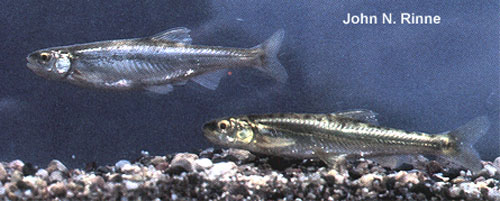| Leuciscidae (Minnows), subfamily: Plagopterinae |
| 9.1 cm TL (male/unsexed) |
|
demersal; freshwater |
| North America: Gila River system in Arizona and New Mexico, USA. |
|
Anal soft rays: 9-9. Meda fulgida can be distinguished by the following characters: anal fin with 9 rays; pharyngeal teeth 1,4-4,1; scales absent; slender body, somewhat compressed at front, strongly compressed at caudal peduncle; slightly subterminal mouth on fairly pointed snout; large eye; pelvic-fin origin before before dorsal-fin origin; olive-gray to light brown above; brilliant silver side, often with blue sheen; back and upper side with black specks and blotches; and bright brassy yellow head and fin bases, yellow belly and fins in breeding males (Ref. 86798). |
| Inhabits sandy and rocky runs and pools and often occurs near riffles of creeks and small rivers (Ref. 86798). |
|
Endangered (EN); Date assessed: 13 April 2012 (B2ab(iii,v)) Ref. (130435)
|
| harmless |
Source and more info: www.fishbase.org. For personal, classroom, and other internal use only. Not for publication.

